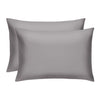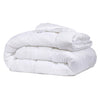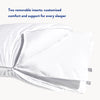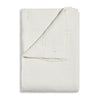The Daily Miracle
How Often Should You Change Your Washcloths?
Published
January 20, 2023
Author
Suze Dowling

We’ve all had that thought during a shower: when was the last time I changed out my washcloths?
Truth be told, it’s easy to forget about cleaning your bathroom items. Plus, considering they’re always drenched in soap, you’d think they’d stay relatively clean.
Believe it or not, your washcloths, loofahs, towels, and bathroom mats are probably some of the dirtiest items in your home. They’re in close contact with all types of germs and bacteria and are left in warm, damp, and dark environments.
Showering can be one of the best parts of the day, and a good shower can offer many benefits. For example, while your body temperature does rise slightly during sleep, a shower before bed can help prevent night sweats.
Don’t get stuck using a dirty washcloth; let’s talk about bathroom linens and when it's time to throw in the towel.
How Do Washcloths Get So Dirty?
Showering is a time of relaxation, and thanks to your trusty washcloth, you can leave feeling rejuvenated and refreshed. However, your washcloths see the best (and worst) parts of you.
But, if you leave your washcloths in the damp and dark shower, they’re likely to pick up some pretty nasty germs. While hanging them up can help them dry out sooner, at some point, replacement is the only viable solution.
Can Using a Dirty Washcloth Be Harmful?
While using a dirty washcloth repeatedly isn’t the most sanitary, it’s generally not likely to cause harm, either. Unless you’re using the washcloth to clean an open wound, the chances of developing an infection are slim.
However, keep in mind that your skin is an organ, and it’s very sensitive to germs and bacteria. If you see an increase in acne, whiteheads, or blackheads, your old washcloth may be to blame.
When Is It Time To Change Your Washcloth?
It’s important to know how often you should change your washcloths. While some people switch them out frequently for aesthetic purposes, others like to get the most bang for their buck and keep them as long as possible.
A good rule of thumb is to replace your washcloths and towels every two years. You’ll know it's time to replace your washcloths once the threads begin to fray, the color is dull and faded, or there is a lingering stench.
It’s normal (expected, even) for your towels and washcloths to develop a mildew scent over time. If you notice a stench but have had your washcloths for less than two years, they may be salvageable. Sometimes mildew can develop if the washcloth doesn’t dry properly or sits in a damp environment for too long.
One way to get mildew out of your towels and washcloths is to use an ultra-concentrated, extra-strength detergent.
However, sometimes normal detergent isn't a match for mildew's powerful smell. If your towels still stink after switching detergents, they’re likely a lost cause, and it may be time to replace them.
How To Preserve the Life of Your Washcloths
Although washcloths can survive for up to two years, they may wear out faster if you don’t properly take care of them. Here are a few tips and tricks we’ve learned to help preserve the life of your washcloths.
Ditch the Fabric Softener
While fabric softener makes your towels smell amazing, it can also build up in the fabric and cause it to fall apart faster. Luckily, you can get the same soft result with a high-quality detergent that won’t cause build-up.
Use Less Detergent
If you’re using more than one to two tablespoons of detergent per load, that’s too much. We know it seems like using that little couldn't possibly get your clothes clean, but laundry detergent is very concentrated. Using too much detergent can damage the fabric and cause detergent build-up, which can contribute to the mildew smell.
Avoid over-pouring your detergent by switching to detergent sheets. Not only are detergent sheets more convenient, but they can also be better for the environment.
Always Let Them Air Out
More than likely, the last thing on your mind post-shower is your washcloth. Still, you should try to make sure you hang it up (out of the shower in a dry area) to help it air out and dry properly.
Damp washcloths are a breeding ground for germs, mildew, and more. Because of this, it’s important to get in the habit of hanging up your washcloths, even if it’s easier to toss them in with the dirty clothes.
Wash With Cold or Warm Water
While hot water may seem more sanitizing, it may also be the culprit behind your dull and faded washcloths. Hot water penetrates deep into the fabric, causing the colors to wash away and fade. You can keep your towels vibrant by washing them with cold water.
Your washcloths should last around two years, so if you’ve been replacing yours more often than that, consider trying our laundry hacks.
How Often Should You Change Your Other Bathroom Items?
Keeping your other bathroom items clean and new is just as crucial as taking care of your washcloths. Germs can grow on your towels, bathroom mats, and sponges. Here are some tips on how often to change your other bathroom linens.
When To Change Your Bathroom Rug
Just like your towels and washcloths, your bath mat is home to lots of bacteria and germs.
Even though it's only in direct contact with your feet, bacteria can travel, so replacing your bath mat and keeping it sanitary should be a top priority.
Like your towels, you should change your bathroom rug every two years while washing it periodically.
When To Change Your Loofah
If you’re more of a loofah type, we’ve got you covered. Whether you’re using a natural or plastic loofah, they should be replaced more often than washcloths.
Bacteria can build up on loofas very quickly, which is why washing them is so important. Every week, soak your loofah in a bleach-based cleansing solution (one part bleach to nine parts water). Soak for five to 10 minutes, then rinse thoroughly.
You should also aim to replace your loofas once every one to two months.
When To Change Your Shower Curtain
If you have a shower door, you can skip this section. But if you’re loyal to the curtain aesthetic, listen up!
Your shower curtain can retain a lot of bacteria. Rather than switching out your curtains whenever you redecorate, you should really wash and switch them out every six months.
This can help you avoid bacteria buildup, mildew or mold growth, and unpleasant scents. If you just got a new shower curtain, try to wash it in a bleach-based solution once every one to two months.
When To Change Your Toothbrush
Your toothbrush is meant to clean your teeth, not dirty them with the past years' worth of bacteria. While bristle wear and tear is enough of a reason to keep your toothbrushes on a bi-monthly rotation, toothbrushes can accumulate a lot of germs that you probably don’t want to have living in your mouth.
We suggest replacing your toothbrush at least every three to four months.
Hello, New Washcloths
Whether you’ve been using the same washcloth for years or you just bought a new set of washcloths, it’s important to know when it’s time to wash your shower gear and when it’s time to call it quits.
It’s important to clean your washcloths regularly and completely switch them out at least once a year. When it’s time to make the switch, look no further than Miracle Made.
Sources:
How To Prevent Color Bleeding in Laundry | HowStuffWorks
How To Prevent and Remove Mildew — Home Methods | MU Extension
The Germiest Place in Your Bathroom Isn't Your Toilet | Time



























